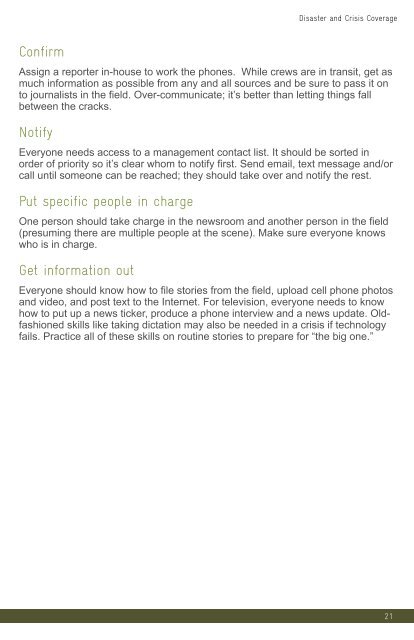Disaster and Crisis Coverage - International News Safety Institute
Disaster and Crisis Coverage - International News Safety Institute
Disaster and Crisis Coverage - International News Safety Institute
Create successful ePaper yourself
Turn your PDF publications into a flip-book with our unique Google optimized e-Paper software.
<strong>Disaster</strong> <strong>and</strong> <strong>Crisis</strong> <strong>Coverage</strong><br />
Confirm<br />
Assign a reporter in-house to work the phones. While crews are in transit, get as<br />
much information as possible from any <strong>and</strong> all sources <strong>and</strong> be sure to pass it on<br />
to journalists in the field. Over-communicate; it’s better than letting things fall<br />
between the cracks.<br />
Notify<br />
Everyone needs access to a management contact list. It should be sorted in<br />
order of priority so it’s clear whom to notify first. Send email, text message <strong>and</strong>/or<br />
call until someone can be reached; they should take over <strong>and</strong> notify the rest.<br />
Put specific people in charge<br />
One person should take charge in the newsroom <strong>and</strong> another person in the field<br />
(presuming there are multiple people at the scene). Make sure everyone knows<br />
who is in charge.<br />
Get information out<br />
Everyone should know how to file stories from the field, upload cell phone photos<br />
<strong>and</strong> video, <strong>and</strong> post text to the Internet. For television, everyone needs to know<br />
how to put up a news ticker, produce a phone interview <strong>and</strong> a news update. Oldfashioned<br />
skills like taking dictation may also be needed in a crisis if technology<br />
fails. Practice all of these skills on routine stories to prepare for “the big one.”<br />
21
















